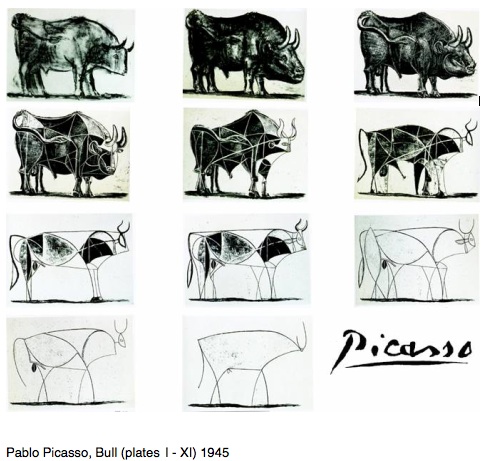Welcome back to the Creative Life Adventure.
I’ve been reading about a fascinating Pablo Picasso work, a series of lithographs Picasso made in December, 1945, and January, 1946. Picasso begins by creating a realistic image of a bull. Then he deconstructs the bull, one step at a time, until what is left is a simple-looking sketch that represents the pure essence of the animal.

Deconstruction is a widely used technique to break something down into its constituent parts to better analyze and understand it. In technical disciplines this is called reverse engineering. This approach can be effective in a literal sense – a car engine can be better understood by taking it apart. The technique can be applied in a more abstract sense: Apparently Apple uses this Picasso work to educate new employees on its design philosophy. Tim Ferriss has made a successful career out of deconstructing work flow, languages, and even people (if you’re not listening to The Tim Ferriss Show podcast, I recommend it).
Deconstruction can also be a useful approach to problem-solving. Breaking down large tasks into smaller steps make it less intimidating, leaving you with the essence of the situation and possibly eliminating unnecessary steps.
There’s another aspect to creativity here. The bull was a common image in Picasso’s work. It is considered metaphorical, with possible interpretations ranging from virility to the rise of fascism in Europe to the brutality and nobility of human nature. Apparently Picasso himself never confirmed any of these interpretations, leaving viewers to use their own creativity in analyzing his works. Creative use of metaphors is another powerful technique in art. It can be powerful in business and our personal lives, when we use stories or anecdotes to illustrate larger concepts.
Think about situations in your own life, significant life experiences or your most fundamental beliefs. Or try the exercise with a favorite poem or painting. Try deconstructing them and understand how they came to be and how they influence your day-to-day thinking. Then create a metaphor or image that conveys the essence of that experience. Try making it an in-depth exercise, take notes, and really get into the fine details of whatever it is you’re examining. The goal isn’t to change beliefs or reinterpret events (although anything is possible!), but to define the essence of something and think of other ways to represent it.
